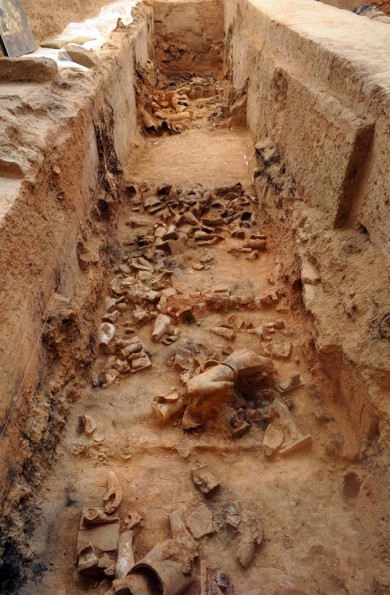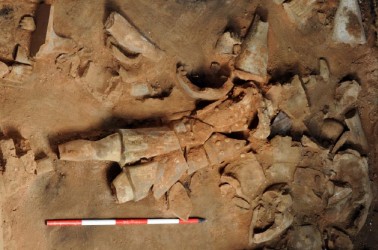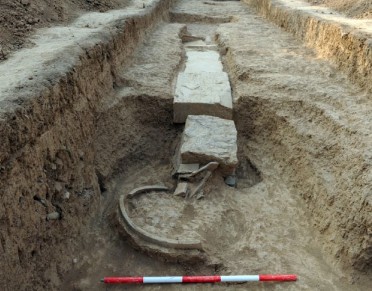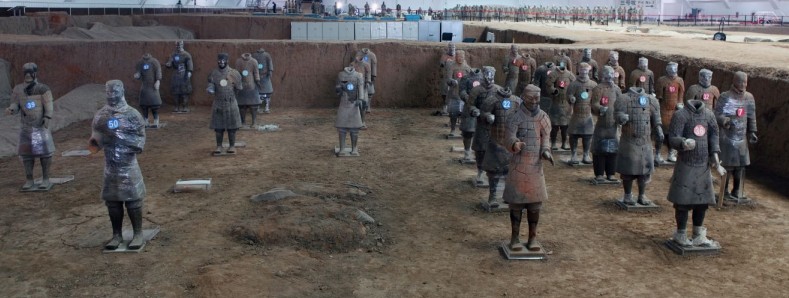Recent Discoveries at the Qin Shihuang Mausoleum Precinct
From:Chinese Archaeology NetWriter:Date:2014-01-08
During 2011-2013 archaeological explorations at the Mausoleum of the First Qin Emperor (Qin Shihuang) have focused on mainly four areas, including K9901 accessory funeral pit, part of the mausoleum, subordinate tombs and the no.1 pit associated with the terracotta army.
1. K9901
K9901 is located between the inner and outer eastern walls in the southeast of the mausoleum. It comprises three compartments which are separated by second-tier platforms and walls, thus presenting a narrow rectangular lying east-west. Traces of trampling are concentrated in the compartments, dating back to the Qin dynasty. Given that the soil found in the upper layer of the pit was largely disturbed, this accessory pit is very likely to have served as builders’ passage during the construction period of the mausoleum. The architectural remains, comprised main parts and east & west doorway, could also be traced back to the Qin dynasty embracing sealing timbers, wooden panels, posts and so forth.

No. 3 compartment in K9901 accessory funeral pit
Archaeological assemblages were discovered at the bottom of the pit deposit. Over 1200 pottery sherds associated with terracotta figurine were recovered at the 2nd and 3rd compartments, among which two figurines were refitted. 980 similar pottery sherds were also found in the 3rd compartment but none in the first one. Thus, it could be tentatively speculated that two rows of terracotta figurine were displayed along the east-west axis against the walls, facing to the chamber. Other findings include 10 bronze objects, 5 stone tools, 20 lead objects and 3 pottery vessels.

No.4 terracotta figurine unearthed from K9901
There is no mound above the funeral pit K9901, indicating its relatively low social status. Its phases of constructing, using and destructed synchronized with the rise and fall of the mausoleum.
2. Remains of Architectures
A set of buildings is situated to the north of the mound, which is 692m in length. These buildings were constructed 3m southern from the mound and extend beyond the northern wall. Both large-scale rammed platform construction and compound structure present. Two rammed earth foundation sit in the southern end of the architectural complex. There are two rows building parts connected by a corridor in between, among which the eastern part consists of raised-floor house and veranda surrounding it while the discovery in the west part is a rectangular foundation. The huge western construction is attached by a corridor leading to a small room with dedicatedly-painted walls. What’s more, it was the first time that mural painting was found in the mausoleum.

The second row drainage system unearthed from architectural complex of mausoleum
The compound complex was found lying to the north of the rammed platform structures. The ten buildings discovered demonstrate a mirrored pattern with a west-east central axis. No.3 structure in the 2nd row, No.1 in the 3rd, No.6 in the 8th, and No.6 and 7 in the 9th are the multiple centers, some of which are surrounded by verandas. No.3 and 4 structures in the 9th row seem to be the gate remains. Pounds, drainages and wells are excavated in No.2 structure in the 1st row and No.3 in the 2ndas well.
The architectures pattern mimics the imperial palace layout during the Qin and Han dynasties where administrative area is usually in the front court and living area in the back court. The north-south axis is the central axis along which the social ranking of these buildings declines from south to north. Considering its layout and historical documents, this architectural complex probably constructed for funeral rites.
3. Attendant tombs
The attendant cemetery is located in the northeastern section of the mausoleum. In general, these tombs are categorized based on the presence of entrance passage. To be more detailed, two different types of entrance passage present; they are slop and shaft. Burials were deposited in eight north-south rows. In the northern corner of the cemetery, remains of rampart were unearthed consisting two layers of rammed earth. Traces of paved passage were recovered as well. Judging from the simple structure of the burials and the absence of grave goods, it is likely to be the cemetery of those who once lived and worked in the royal palace. Moreover, skeletal parts belonging to juvenile female individuals scattered randomly in the tomb deposits. Such bones with dismembering marks were also found in several tomb entrance passages, possibly suggesting lower social status. This phenomenon is interpreted as the redundancy of the Qin Shihuang’s court members.

No.1 Terracotta army pit T23
4. Terracotta army pit
The excavation coding T23 concentrates on the middle section of the northern part in No.1 terracotta army pit including surveys of the two compartments: G8 and G11. Within G8, 31 features were identified and 55 terracotta figurines along with 42 objects were excavated while in G11, 31 features, 51 terracotta figurines and 126 objects were recognized. A deposit of red burned earth was found against the northern wall of G11 and it seems to be evident that tomb robbers once used it as an entrance to the pit. Another robbery hole saturates the west wall of T23. Interestingly, two terracotta figurines in the west section of G11 were facing towards the east, being totally different from others. Regarding that four high-ranking officer figurines were positioned close by, such pattern might reflect the military phalanx.
(Translator: Dong Ningning)
(Translator: Dong Ningning)

